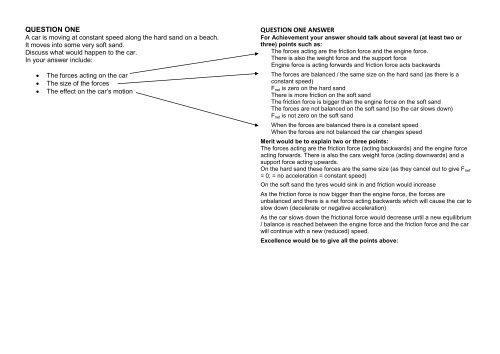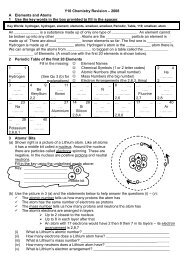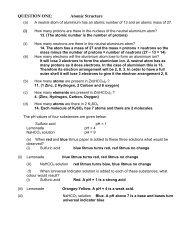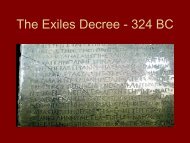Physics Answers
Physics Answers
Physics Answers
You also want an ePaper? Increase the reach of your titles
YUMPU automatically turns print PDFs into web optimized ePapers that Google loves.
QUESTION ONE<br />
A car is moving at constant speed along the hard sand on a beach.<br />
It moves into some very soft sand.<br />
Discuss what would happen to the car.<br />
In your answer include:<br />
<br />
<br />
<br />
The forces acting on the car<br />
The size of the forces<br />
The effect on the car’s motion<br />
QUESTION ONE ANSWER<br />
For Achievement your answer should talk about several (at least two or<br />
three) points such as:<br />
The forces acting are the friction force and the engine force.<br />
There is also the weight force and the support force<br />
Engine force is acting forwards and friction force acts backwards<br />
The forces are balanced / the same size on the hard sand (as there is a<br />
constant speed)<br />
F net is zero on the hard sand<br />
There is more friction on the soft sand<br />
The friction force is bigger than the engine force on the soft sand<br />
The forces are not balanced on the soft sand (so the car slows down)<br />
F net is not zero on the soft sand<br />
When the forces are balanced there is a constant speed<br />
When the forces are not balanced the car changes speed<br />
Merit would be to explain two or three points:<br />
The forces acting are the friction force (acting backwards) and the engine force<br />
acting forwards. There is also the cars weight force (acting downwards) and a<br />
support force acting upwards.<br />
On the hard sand these forces are the same size (as they cancel out to give F net<br />
= 0; = no acceleration = constant speed)<br />
On the soft sand the tyres would sink in and friction would increase<br />
As the friction force is now bigger than the engine force, the forces are<br />
unbalanced and there is a net force acting backwards which will cause the car to<br />
slow down (decelerate or negative acceleration)<br />
As the car slows down the frictional force would decrease until a new equilibrium<br />
/ balance is reached between the engine force and the friction force and the car<br />
will continue with a new (reduced) speed.<br />
Excellence would be to give all the points above:
speed (m s -<br />
1 )<br />
25<br />
20<br />
15<br />
10<br />
5<br />
0<br />
QUESTION TWO<br />
A family drives their 800 kg car to a holiday house to enjoy<br />
their summer holiday. Part of their journey is represented by<br />
the speed-time graph shown below:<br />
(a) Calculate the acceleration acting during the first 20<br />
seconds.<br />
(b)<br />
Section A<br />
0 20 40 60 80 100 120<br />
Calculate the Work done during the first 20 seconds<br />
time (s)<br />
QUESTION TWO ANSWERS<br />
Part a) and b)<br />
Achievement is correct calculation of acceleration<br />
OR calculation of Force (using incorrect value for a)<br />
OR correct calculation of distance travelled. Units must be given.<br />
a = gradient of line = change in v / t = 25 / 20 = 1.25 m s -2<br />
Merit is correct calculation of acceleration<br />
AND correct calculation of Force (using incorrect value for a)<br />
OR correct calculation of distance travelled. Units must be given.<br />
W = Fd<br />
F = ma = 800 x 1.25 = 1000 N<br />
d = area under line for first 20 seconds = ½ x base x height<br />
d = 0.5 x 20 x 25 = 250 m<br />
Excellence is correct answer for Work with all working shown and units<br />
W = Fd = 1000 x 250 = 250 000 J<br />
Part C<br />
Achievement would be to give two or three of the points given below:<br />
The car has a constant velocity (is not accelerating)<br />
The total force acting on the car is zero<br />
The forces on the car are balanced<br />
Work = Change in energy<br />
E k = ½ mv 2 = ½ x 800 x 25 2 = 250 000 J<br />
(c)<br />
Explain (in a <strong>Physics</strong> sense) why the graph shows that<br />
there was no Work done between time = 20 seconds<br />
and time = 60 seconds. Include in your answer:<br />
The motion of the car during that time and what<br />
that tells us about the forces involved<br />
What work is<br />
At least one energy calculation<br />
Merit would be to give at least one of the points listed below<br />
Because the car has a constant velocity it is not accelerating (a = 0) and so the<br />
total Force acting on the car is 0 (F = ma = m x 0 = 0)<br />
Work = Fd and as F = 0 then Work = 0 x distance = 0 J<br />
Work = Change in energy and the energy is not changing between t = 20 s and t<br />
= 60 s because the car has the same (Kinetic) energy over that time as velocity is<br />
not changing (E k = ½ mv 2 )<br />
Excellence would be to give at least two of the points required for Merit
QUESTION THREE<br />
While a 1200 kg car is moving at 20 m s -1 , a dog runs across the road in<br />
front of it. When the driver applies the brakes, the car stops in a<br />
distance of 25 metres.<br />
a) Calculate the average force acting on the car when the<br />
driver applies the brakes. Your answer should include:<br />
Any energy transformations that take place<br />
Any assumptions you have made<br />
All calculations with working<br />
an appropriate unit with your answer.<br />
b) Use your answer from a) to calculate the time it takes for the car to<br />
stop<br />
c) If the car had been travelling uphill would it have taken a greater or<br />
lesser distance to stop? Discuss your answer in terms of:<br />
The forces acting on the car<br />
Any energy transformations that take place<br />
QUESTION THREE ANSWERS<br />
Achievement would be to give two of the points given below:<br />
Kinetic energy is changed into heat energy (Work done by friction)<br />
Assuming all Kinetic energy is changed into Heat (Work done by friction)<br />
Work done to stop car = Kinetic energy of car<br />
E k = ½ mv 2 = ½ x 1200 x 20 2 = 240 000 J (Working must be shown)<br />
(Or Merit calculation done correctly with incorrect E k value)<br />
Merit is all points for Achieved as well as force calculation done<br />
W = Fd = 240 000 so F = 240 000 / d = 240 000 / 25 = 9600 N<br />
Part b)<br />
Achievement is one calculation done correctly<br />
F = ma so a = F / m = 9600 / 1200 = 8 m s -2 (Or carried error using your answer<br />
from a))<br />
a = change in v / t so t = change in v / a = 20 m s -1 / 8 = 2.5 s (Or carried error if<br />
the calculation of a is incorrect)<br />
Merit is both calculations done correctly<br />
Part c)<br />
Achievement would be to give two of the points given below:<br />
The car would take less distance to stop<br />
The forces slowing the car would be bigger so the car would stop quicker (in less<br />
distance) OR The weight force of the car is partly acting backwards slowing the<br />
car<br />
Kinetic energy is being turned into heat and sound AND Gravitational Potential<br />
Energy<br />
Merit would be to give at least one of the points listed below<br />
Because the weight force is (partly) acting backwards this means that the total<br />
force stopping the car will be bigger than just the force being applied by the<br />
brakes<br />
On the flat all the E k of the car would have to be turned into heat and sound by<br />
the brakes. But as the car is going uphill some of the E k is being turned into E p so<br />
there is less to be transformed by the brakes so the car stops sooner.<br />
Excellence is to extend the points given for Merit<br />
If F (back) is bigger; than a = F/m is bigger and v will decrease to 0 faster.<br />
If some E k is turned into Ep then W (done by brakes) will be less and since w =<br />
Fd then d = W / F so smaller W = smaller stopping distance
QUESTION FOUR<br />
A student cycles to school each day. He must ride over the steep hill<br />
between his home and school. The combined mass of the bike and<br />
student is 70kg.<br />
He has a new speedometer and records his speed at various times as in<br />
the table.<br />
Time (s) 0 120 240 360 480 540 600<br />
Speed (ms -1 ) 0 2.5 2.5 1.2 1.2 9.0 0<br />
QUESTION FOUR ANSWERS<br />
For Achievement you require Part (i) OR part of (ii) correct (a)<br />
a = change in speed = 2.5 = 0.02 ms -2<br />
Change in time 120<br />
OR<br />
W=Fd - correct calculation of force or distance (units not needed) or carry<br />
through error from part (i) in F=ma<br />
This data is shown on the grid below.<br />
Speed (m s -1 )<br />
10<br />
9<br />
8<br />
7<br />
6<br />
5<br />
4<br />
3<br />
2<br />
1<br />
0<br />
0 100 200 300 400 500 600 700<br />
Time (s)<br />
(i) Calculate the acceleration of the student on his bike in the<br />
first 120 seconds.<br />
For Merit you require part (i) correct (a = 0.02 ms -2 ) AND part of (ii) with<br />
correct force or distance with unit (m)<br />
F = ma<br />
OR<br />
= 70 x 0.02 = 1.4 N (allow 1.46 if a unrounded)<br />
Distance = area under graph or d = v (av) t<br />
= 120 x 2.5<br />
2 = 150m<br />
For Excellence you require ALL answers correct with units (e)<br />
W=Fd<br />
F= ma = 70 x 0.02 = 1.4 N<br />
d = area under graph or d = v (av) t<br />
= 120 x 2.5<br />
2 = 150m<br />
(ii)<br />
Calculate the work done by the cyclist in this time.<br />
Additional Question over page<br />
W = Fd = 1.4 x 150 = 210J
(iii)<br />
Compare the forces as the student on his bike goes up the hill<br />
(between 240 and 360 s) with the forces as he goes down the<br />
hill (between 480 and 540 s). In your answer:<br />
<br />
<br />
Explain which requires more effort and why.<br />
Use appropriate force calculations in your<br />
comparisons.<br />
For Achievement you require ONE correct statement (a)<br />
More effort is needed going uphill as he must overcome gravity / weight force (a)<br />
OR<br />
Net force is much higher downhill as he is accelerating with assistance from<br />
gravity (a) OR<br />
Calculation of forces ie.<br />
Uphill F = ma = 70 x 1.3/120 =0.76N<br />
Downhill F = ma = 70 x 7.8/60= 9.1N (a)<br />
For Merit you need to correctly compares forces OR effort with explanation<br />
(m)<br />
More effort is needed going uphill as he must overcome gravity / weight force is<br />
added, whereas going downhill gravity / weight is in the direction of travel so aids<br />
the thrust from the cyclist (m)<br />
OR<br />
Net force is much higher downhill as he is accelerating due to assistance of<br />
gravity.<br />
Calculation of force downhill<br />
F=ma = 70 x 7.8/60 = 9.1 N<br />
Uphill F=ma = 70 x 1.3/120 = 0.76 N ie. lower / decelerating as cyclist’s thrust<br />
force is acted against by the weight force he must overcome (m)<br />
For Excellence you need to have a comparison of forces and effort both<br />
uphill and downhill (e)<br />
Going uphill requires more effort because the cyclist must overcome his 700N<br />
weight force, ie. he is lifting himself and his bike uphill as well as moving along.<br />
This causes deceleration, and a net force of only 0.76 N, ie. it is difficult to<br />
maintain his speed due to the extra effort in lifting the bike against gravity. When<br />
travelling downhill, the bike will roll naturally as its weight force acts in a<br />
downward direction, carrying the bike and rider down the hill. Any extra effort the<br />
rider adds as thrust by peddling effectively adds to this, ie. the bike accelerates<br />
rapidly (from 1.2 m/s to 9 m/s) with a net force of 9.1 N
QUESTION FIVE<br />
New car models are crash tested under laboratory conditions to<br />
ensure that safety standards are met. A 1500 kg car is accelerated<br />
to a speed of 30 ms -1 from stationary in 6 seconds, before hitting a<br />
brick wall without braking.<br />
(a) Calculate the force the causes the car to accelerate.<br />
Modern cars are built with crumple zones, this means that the cars<br />
are designed to fold up (crumple) as they hit an object. This results<br />
in a lot more damage to the car, but reduces injury to the<br />
passengers by increasing the TIME the car takes to stop completely<br />
during a crash.<br />
(b)<br />
Crumple zone<br />
Discuss the energy and forces involved as the car drives<br />
towards the wall, then crashes into it. In your answer:<br />
Describe the energy transformations that take<br />
place<br />
Calculate the energy the car has the instant<br />
before it hits the wall<br />
Explain how the crumple zone works to reduce the<br />
force on impact and reduce injury<br />
QUESTION FIVE ANSWERS<br />
(a) Achievement requires correct acceleration calculation (a)<br />
a = 30/6 = 5 ms -2<br />
Merit requires correct force calculation from acceleration (m)<br />
F = ma = 1500 x 5<br />
= 7500 N<br />
(b) Achievement requires ONE correct statement (a)<br />
Eg:<br />
Kinetic energy heat energy (as friction) + sound (a)<br />
(sound not required)<br />
OR<br />
Kinetic energy calculated<br />
Energy E k = 1/2mv 2 = ½ x 1500 x 30 2 = 675000 J (675kJ)<br />
Merit requires Energy transformation AND kinetic energy calculation OR<br />
explanation of crumple zone (m) Eg:<br />
Kinetic energy heat energy (as friction) + sound AND<br />
Energy E k = 1/2mv 2 = ½ x 1500 x 30 2 = 675000 J (675kJ) (m)<br />
OR<br />
Crumple zone increases stopping time, ie. deceleration is less which decreases<br />
the forces (F = ma) (m)<br />
Excellence needs discussion energy transformation, with kinetic energy or<br />
force linked to explanation of crumple zone (e) Eg:<br />
The car has a large amount of kinetic energy, ie.<br />
E k = 1/2mv 2 = ½ x 1500 x 30 2<br />
= 675000 J (675kJ) just before it hits the wall.<br />
All of this energy must be transformed as the car stops, mostly into heat through<br />
friction, and some sound. As the car hits the wall, it decelerates rapidly, giving a<br />
very large force. A crumple zone allows the car to stop more slowly, ie. it<br />
decreases the deceleration by allowing the energy to be releases as heat over a<br />
longer time. Using F = ma, if a is smaller due to longer stopping time, then force<br />
must be less. If a passenger’s body decelerates more slowly with less force, less<br />
damage/injury will result. A car with no crumple zone will stop completely more<br />
quickly, ie. large deceleration so a larger force and greater damage. (e)
QUESTION SIX: IN THE GYM<br />
Two men were lifting weights in the gym. They were lifting a bar<br />
with weights that had a total mass of 80 kg.<br />
(a) State the total weight they were lifting and explain the<br />
difference between mass and weight.<br />
The two men were bench pressing the weights (pushing the<br />
weights upwards from their chest as far as their arms could extend).<br />
One man’s arms were 0.65 m long and the other man’s were 0.60<br />
m long. Both men took exactly 2.5 seconds to fully extend their<br />
arms.<br />
The man with the longer arms said that he had to do more<br />
work than the man with the shorter arms but the man with the<br />
shorter arms was more powerful.<br />
(b)<br />
Discuss the statement (in bold above).<br />
In your answer, you should:<br />
calculate the work done by each man<br />
calculate the power exerted by each man<br />
compare the results with the statement in bold and explain<br />
your findings<br />
QUESTION SIX ANSWERS: IN THE GYM<br />
a) Calculation of weight: F w = mg = 80 x 10 = 800 N<br />
Explanation of difference:<br />
Mass is the amount of material / matter in an object.<br />
Weight is the gravitational force on an object (not the amount of gravity).<br />
b) Calculation of work:<br />
Long arms W = F x d = 800 x 0.65 = 520 J<br />
Short armsW = F x d = 800 x 0.60 = 480 J<br />
Calculation of power:<br />
Long arms P = W/t = 520 / 2.5 = 208 W<br />
Short arms P = W/t = 480 / 2.5 = 192 W<br />
OR statement that both took the same time to lift weights therefore the man that<br />
did the most work also exerted the most power.<br />
Comparison with statement:<br />
Man with longer arms did the most work as he exerted the same force over a<br />
greater distance. However, man with the longer arms was also exerting more<br />
power as he did the greater amount of work in the same time.<br />
For Achievement your answer should have two of:<br />
in (a), calculates the weight correctly OR makes an accurate statement<br />
about mass or weight<br />
in (b), one calculation is undertaken by selecting and substituting into the<br />
correct formula and solving it<br />
in (b), long armed man identified as either doing the most work or<br />
as exerting the most power<br />
For Merit your answer should have both of:<br />
in (a), calculates the weight correctly AND distinguishes between mass<br />
and weight<br />
in (b), correctly calculates work for both men AND calculates power<br />
correctly for one man OR makes a statement comparing work over the<br />
same time with power.<br />
For Excellence your answer should have both of:<br />
in (b), correctly calculates work for both men AND calculates power<br />
correctly for both men OR makes a statement comparing work over the<br />
same time with power for both men.<br />
in (b), compares results with statement and explains either the difference<br />
in work Or difference in power
QUESTION SEVEN: PRESSURE<br />
Hayley and Sarah were running across the football field. Hayley has a<br />
mass of 54 kg and Sarah has a mass of 60 kg.<br />
(a) Sarah was running with a forward force of 65 N and a friction force<br />
of 50N. Calculate the acceleration of Sarah.<br />
Hayley was wearing football boots and Sarah was wearing<br />
running shoes. Hayley noticed that when they both stood still,<br />
she left marks in the field but Sarah did not.<br />
QUESTION SEVEN ANSWERS: PRESSURE<br />
a) Calculation of acceleration:<br />
F net = m x a so a = F net / m = 15 / 60 = 0.25 ms -2<br />
b) Calculation of pressure:<br />
Hayley<br />
P = F/A Force is F w = mg = 54 x 10 = 540N<br />
Area is that of studs A = 0.0001 x 12 = 0.0012 m 2<br />
P = 540 / 0.0012 = 450 000 Pa<br />
Sarah<br />
P = F/A Force is F w = mg = 60 x 10 = 600N<br />
Area of both shoes A = (0.10 x 0.27)x2 = 0.054 m 2<br />
P = 600 / 0.054 = 11 111 Pa<br />
The bottoms of their shoes are shown below:<br />
Each stud<br />
has a surface<br />
area of<br />
Hayley’s<br />
football boots<br />
Sarah’s running<br />
shoes<br />
Length<br />
= 0.27 m<br />
Discussion of physics principles:<br />
1. Sarah’s running shoes have a much larger area than the studs on<br />
Hayley’s boots.<br />
2. P = F/A so as A increases the pressure must get smaller.<br />
3. Even though Sarah is heavier, her weight is distributed over a<br />
larger area while Hayley’s is applied over a small area.<br />
Hayley puts more pressure on the ground causing the studs to ‘sink in’<br />
and leave marks.<br />
For Achievement your answer should have two of:<br />
in (a), net force is calculated OR formula correctly arranged but<br />
incorrect force value substituted<br />
in (b), calculates the area or weight force for one person correctly<br />
in (b), states that Hayley leaves marks as her boots exert more<br />
pressure<br />
0.0001 m 2 Average width = 0.10 m<br />
(b) Discuss the physics principles that caused Hayley to<br />
leave marks while Sarah, who was heavier, did not.<br />
Include calculations in your answer.<br />
For Merit your answer should have two of:<br />
in (a), net force is calculated AND correct acceleration<br />
calculated including unit<br />
in (b), shows an understanding of how the two formula should<br />
be applied to each person but fails to give correct pressures or<br />
units<br />
in (b), shows an understanding of the physics principles<br />
involved by stating that smaller area of studs would exert more<br />
pressure than area of running shoes<br />
For Excellence your answer should have everything
QUESTION EIGHT: CONSERVATION OF ENERGY<br />
Josh is skateboarding on the local half-pipe. The top of the half-pipe<br />
is 2 m above the bottom of the half-pipe. Josh and his board have a<br />
total mass of 70 kg.<br />
Point B<br />
2 m<br />
Point A<br />
(a) Calculate the gravitational potential energy of Josh at the top<br />
of the half-pipe.<br />
(b) Use your answer from (a) above to calculate the speed Josh<br />
would be expected to be travelling at the bottom of the half-pipe.<br />
(c) Describe the energy changes involved in skating from point<br />
A to point B and discuss whether it is possible for Josh to skate<br />
from point A to point B without putting in any effort of his own.<br />
QUESTION EIGHT ANSWERS: CONSERVATION OF ENERGY<br />
a) Calculation of gravitational potential energy:<br />
E P = mgh = 70 x 10 x 2 = 1400 J<br />
b) Calculation of speed:<br />
E K = 2<br />
1 mv<br />
2<br />
Assume all gravitational energy would be converted to kinetic energy<br />
1400 = 2<br />
1 x 70 v<br />
2<br />
so v 2 = 40 so v = 6.3 m s -1<br />
c) Description of energy changes:<br />
At point A he has all gravitational potential energy and no kinetic energy.<br />
At the bottom of the ramp he has all kinetic energy and no gravitational<br />
potential energy (the gravitational potential energy has been changed to<br />
kinetic).<br />
At point B all the kinetic has been transferred back into gravitational potential<br />
energy.<br />
Discussion of energy conservation:<br />
Between A and B some of the kinetic energy has been converted into heat<br />
due to work done by friction. This loss of energy means that Josh would not<br />
be able to reach all the way to point B.<br />
For Achievement your answer should have two of:<br />
in (a), uses the correct formula in an attempt to calculate gravitational<br />
potential energy OR gives correct value but no unit<br />
in (b), recognises that gravitational energy will be converted to kinetic<br />
energy OR selects the correct formula and attempts the calculation by<br />
substituting all values except v<br />
in (c), identifies the type of energy at each of the three points (A, bottom of<br />
ramp, and B) OR recognises that energy is being lost therefore Josh won’t<br />
reach point B<br />
For Merit your answer should have two of:<br />
in (a), calculates correct gravitational potential energy and gives unit<br />
in (b), selects the correct formula and substitutes correctly (using value<br />
from a) and gives unit<br />
in (c), accurately describes all of the mechanical energy changes taking<br />
place from point A to point B OR recognises that energy is being lost as<br />
heat therefore Josh won’t reach point B<br />
For Excellence your answer should have everything
QUESTION NINE: MOTION-TIME GRAPHS<br />
A passenger training for a harbour swim boards a ferry that travels<br />
from wharf A across the harbour to wharf B.<br />
The ferry leaves wharf A and slowly accelerates. It takes 150 s to<br />
travel the first 500 m. The ferry then travels the next 2000 m at a<br />
constant speed. This section of the journey takes 300 s. The ferry<br />
decelerates over the final 500 m, taking a further 150 s.<br />
(a)<br />
Sketch a distance-time graph for the ferry’s journey.<br />
(b) (i) Calculate the average speed of the ferry during the<br />
journey.<br />
The same passenger then dives off wharf B and swims across the<br />
harbour to the far shore as shown in the speed-time graph below.<br />
Speed<br />
(ms -1 )<br />
0.8<br />
0<br />
Section<br />
A<br />
Speed-time graph for swim across the<br />
harbour<br />
Section<br />
B<br />
400 4000<br />
Section<br />
C<br />
(b) (ii) Calculate the distance the person swam while her<br />
speed was changing.<br />
Time (s)<br />
(c) Discuss whether the forces on the swimmer are balanced or<br />
unbalanced during each section of the swim and how this results in<br />
the types of motion produced.<br />
4500<br />
QUESTION NINE ANSWER: MOTION-TIME GRAPHS<br />
a) Plotting graph correctly and drawing of correct graph shapes:<br />
3000<br />
2500<br />
tra<br />
vell<br />
ed<br />
(m)<br />
500<br />
b) (i) Calculation<br />
0<br />
of average<br />
1 2<br />
speed:<br />
3 4<br />
v = d/t<br />
5 6<br />
= 3000/600 = 5 m s -1<br />
(ii) Calculation of distance:<br />
0<br />
Only<br />
0<br />
applies<br />
0<br />
to<br />
0<br />
section e 0<br />
A and<br />
0<br />
C<br />
Area of section A: 0.5 x<br />
0<br />
400<br />
0<br />
x 0.8<br />
0<br />
= 160<br />
0<br />
m (sec 0 0<br />
Area of section C: 0.5 x 500 x 0.8 = 200 m onds<br />
Total distance = total area 160 + 200 ) = 360 m<br />
c) Explanation of motion:<br />
Section A: Forces are unbalanced; there is a net force in the forward direction causing the<br />
swimmer to accelerate.<br />
Section B: Forces are balanced; there is zero net force, therefore swimmer moving at<br />
constant speed.<br />
Section C: Forces are unbalanced; there is a net force in the backward direction causing<br />
the swimmer to decelerate.<br />
For Achievement your answer should have two of:<br />
in (a), completes the graph accurately showing correct graph shapes for at least two<br />
sections (with the y axis labelled correctly).<br />
in (b), attempts to calculate average speed (E.g. writes the formula and substitutes<br />
values OR finds average speed but does not give the unit). AND recognises the distance<br />
as the area under the speed-time graph (E.g. attempt made at finding an area of any of<br />
the three sections).<br />
in (c), shows understanding that section B represents constant speed and A and C<br />
represent changing speed.<br />
In (c) correctly states whether forces are balanced or unbalanced for each section.<br />
For Merit your answer should have two of:<br />
in (a), draws accurate graph with appropriate shapes for all three sections<br />
in (b), calculates average speed correctly (with unit) AND calculates the area under at<br />
least one section of the graph and states the distance.<br />
in (c), states whether the forces are balanced or unbalanced for two sections of the<br />
graph AND links them to the motion. (balanced = constant speed, unbalanced =<br />
acceleration)<br />
For Excellence your answer should have everything

















